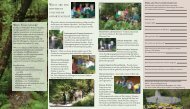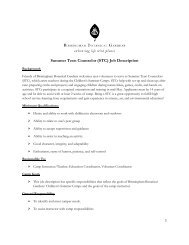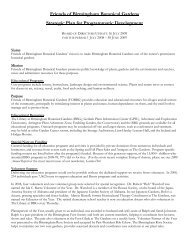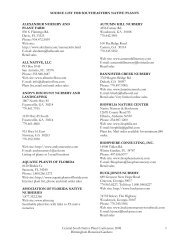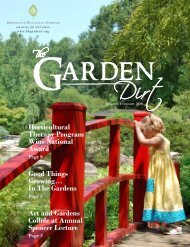Good Things Growing… - Birmingham Botanical Gardens
Good Things Growing… - Birmingham Botanical Gardens
Good Things Growing… - Birmingham Botanical Gardens
You also want an ePaper? Increase the reach of your titles
YUMPU automatically turns print PDFs into web optimized ePapers that Google loves.
<strong>Good</strong> <strong>Things</strong> <strong>Growing…</strong>In The <strong>Gardens</strong><br />
More information on growing Pieris…<br />
While working in the northeast, I ran across (and planted) hundreds of Pieris japonica,<br />
including a number of cultivars. ‘Dorothy Wycoff’ and ‘Valley Valentine’ were the two<br />
most often encountered, with screaming red new growth, and pinkish flowers,<br />
respectively. ‘Variegata’ is a very handsome form with creamy-white leaf edges that<br />
grows even slower than the species. I imagine the performance of all these cultivars to be<br />
like the species in <strong>Birmingham</strong>: iffy, but not impossible if given perfect growing<br />
conditions and a dose of patience. We have several small plants of ‘Variegata’ planted in<br />
dense shade in the Hosta Walk and they look fine two years after planting. One plant<br />
each of the previous two cultivars are languishing in the McReynolds Garden, probably<br />
due to excess soil moisture.<br />
Pieris japonica (and its hybrids and cultivars) grows slowly with an elegant, upright and<br />
layered habit, slightly taller than wide with age. Landscape size is generally 5’ tall x 4’<br />
wide after about 15 years; a 10’ tall plant would be very old, especially in the southeast.<br />
The semi-erect to drooping, 3-8” long racemes of flower buds emerge in late summer-fall<br />
at the branch tips, and open over a long time period – up to two months – in early winter<br />
in <strong>Birmingham</strong>. The flowers are white, bell-shaped, fragrant enough to wake up the bees<br />
on a cool winter day, and are quite frost-tolerant.<br />
The flowers look like lilies-of-the-valley, and lily-of-the-valley-shrub is sometimes listed<br />
as a common name, which does no good if one does not know what a lily-of-the-valley is.<br />
Also confusing is the common name andromeda, which is also the common name for<br />
Andromeda polifolia, bog andromeda, or bog rosemary, a related, diminutive relative of<br />
cold mountain and maritime bogs.<br />
The difficulty with growing Pieris japonica and kin here is directly related to excess heat<br />
and soil moisture. Protection from heat and direct sun is critical; locations against<br />
structures with northern exposures are well-advised if shade from trees is not available.<br />
Soil must be acid, high in organic matter and very well-drained. Frankly, if you’re not<br />
able to supply all these ingredients, you probably should grow something else.<br />
Lacebugs can attack pieris, often in large numbers. These insects feed from underneath<br />
leaves, piercing the leaf cuticle and sucking out plant juices. Lacebug damage appears as<br />
rusty stippling on leaf surfaces and lasts until the leaves fall off (several years). Contact<br />
sprays are ineffective as controls, unless leaf undersides are sprayed – which is not easy –<br />
in a timely manner; expensive systemic treatments provide more long-term control.<br />
However, plants sited in deep shade typically show far less lacebug damage than those in<br />
sunnier positions because lacebug predators, primarily small spiders, are present in<br />
greater numbers in shadier spots, and plants are generally less stressed (stressed plants<br />
being prone to attack). If you successfully grow Pieris, even healthy and vigorous ones,<br />
you will have a few lacebugs; this should not be a cause for concern or spraying. Finally,<br />
don’t confuse lacebugs with lacewings, which are beneficial insects.
Pieris floribunda, mountain pieris (or mountain fetterbush), has not been historically tried<br />
at BBG, and for good reason, as this is a plant of cool, high elevations in the southern<br />
Appalachians. Nevertheless, it has transferred some heat tolerance (and lacebug<br />
resistance) to the hybrids named in the main article. Flower racemes tend to be shorter<br />
than P. japonica, and flowers appear in early spring. If you have a vacation home in the<br />
mountains, perhaps it’s worth a try, but not in <strong>Birmingham</strong>. The lack of broad<br />
adaptability of this species and the next may be due to the need for specific associations<br />
of symbiotic mycorrhizal fungi, which are seldom found outside of native habitats.<br />
We have another native pieris, Pieris phillyreifolia, or climbing fetterbush. It is restricted<br />
to raised hummocks and well-drained stream banks in extreme coastal MS, AL, GA and<br />
SC, and through the panhandle and into central Florida. According to the literature – and<br />
the common name – the plant often climbs up the trunks of trees (baldcypress, water<br />
gum) in shaded, swampy areas, which would lead one to believe it prefers moist soils.<br />
Examination of plants in the wild, however, shows this climbing tendency to be very<br />
weak, and that the plants are above water in well-drained, sandy to organic soils (leaf<br />
humus). The predominant growth habit is of a low (10-15”) stoloniferous groundcover.<br />
Flowers are not heavily borne, but are typical for Pieris, although shorter (1-4” racemes)<br />
and smaller. Leaves are dark green with a matte finish. We planted (and lost) several P.<br />
phillyreifolia in the wetter areas of the Barber Alabama Woodlands before obtaining a<br />
plant of the cultivar ‘Baldwin’, introduced from Tom Dodd Nurseries in Loxley, AL.<br />
This taller form was found growing in Baldwin County, in a sunny location in sandy soil.<br />
We grow it in the Hosta Walk, where it seems pretty happy in half-sun.<br />
Pieris taiwanensis, sometimes listed as P. japonica var. taiwanensis, appears somewhat<br />
confused in both the literature and the trade. Most commonly, it is represented by the<br />
cultivars ‘Snow Drift’ and, perhaps, ‘Prelude’. Obviously hailing primarily from Taiwan,<br />
it is said to be found only at higher elevations there and may not confer the heat tolerance<br />
of many Taiwanese endemics. Minor taxonomic and geographic differences aside, it<br />
seems to be smaller than typical P. japonica, and our young plants of ‘Prelude’ in the<br />
Hulsey Woods are very compact (15” in all dimensions). They are in a dry location in<br />
half sun and although they flower well, they appear washed-out-green in winter and halfbaked<br />
in summer.<br />
Lastly, the plant masquerading through the southeast (albeit in very limited numbers) as<br />
Crabiodendron yunnanense, is probably Pieris ryukyuensis, and likely the same as the<br />
cultivar ‘Temple Bells’ (mentioned in the main article). We have one near the wishing<br />
well in the Curry Rhododendron Garden and another in the Asian Glade, near the<br />
vegetated swale. Despite their slow growth, both seem happy enough and do flower<br />
nicely. To me, their fragrance is not as strong as P, japonica, but overall, they are very<br />
healthy. Further trials with ‘Temple Bells’ will help us to determine if our<br />
Crabiodendron are true to name or mere imposters.



